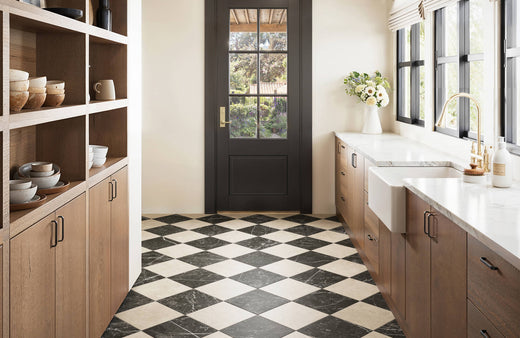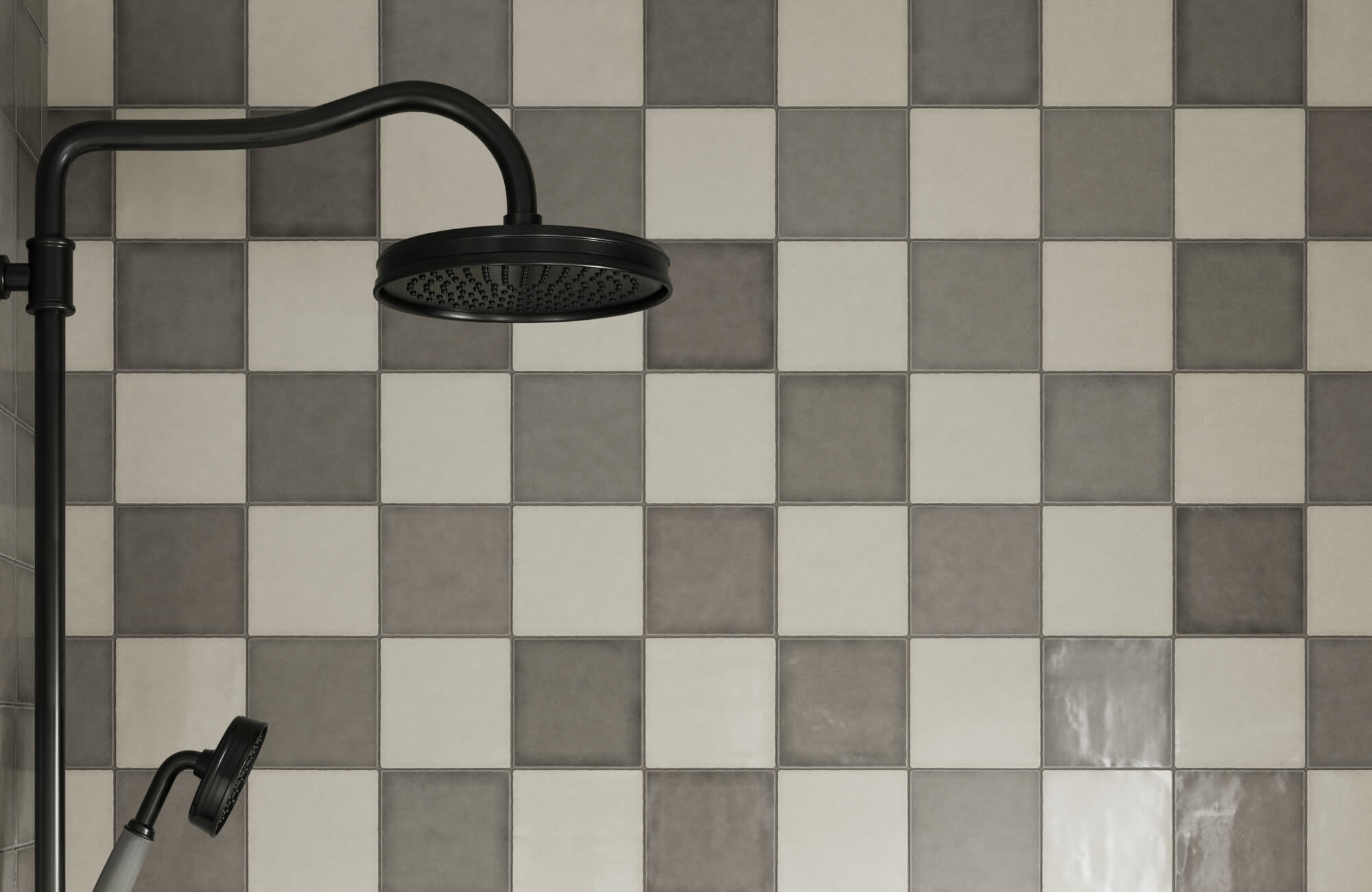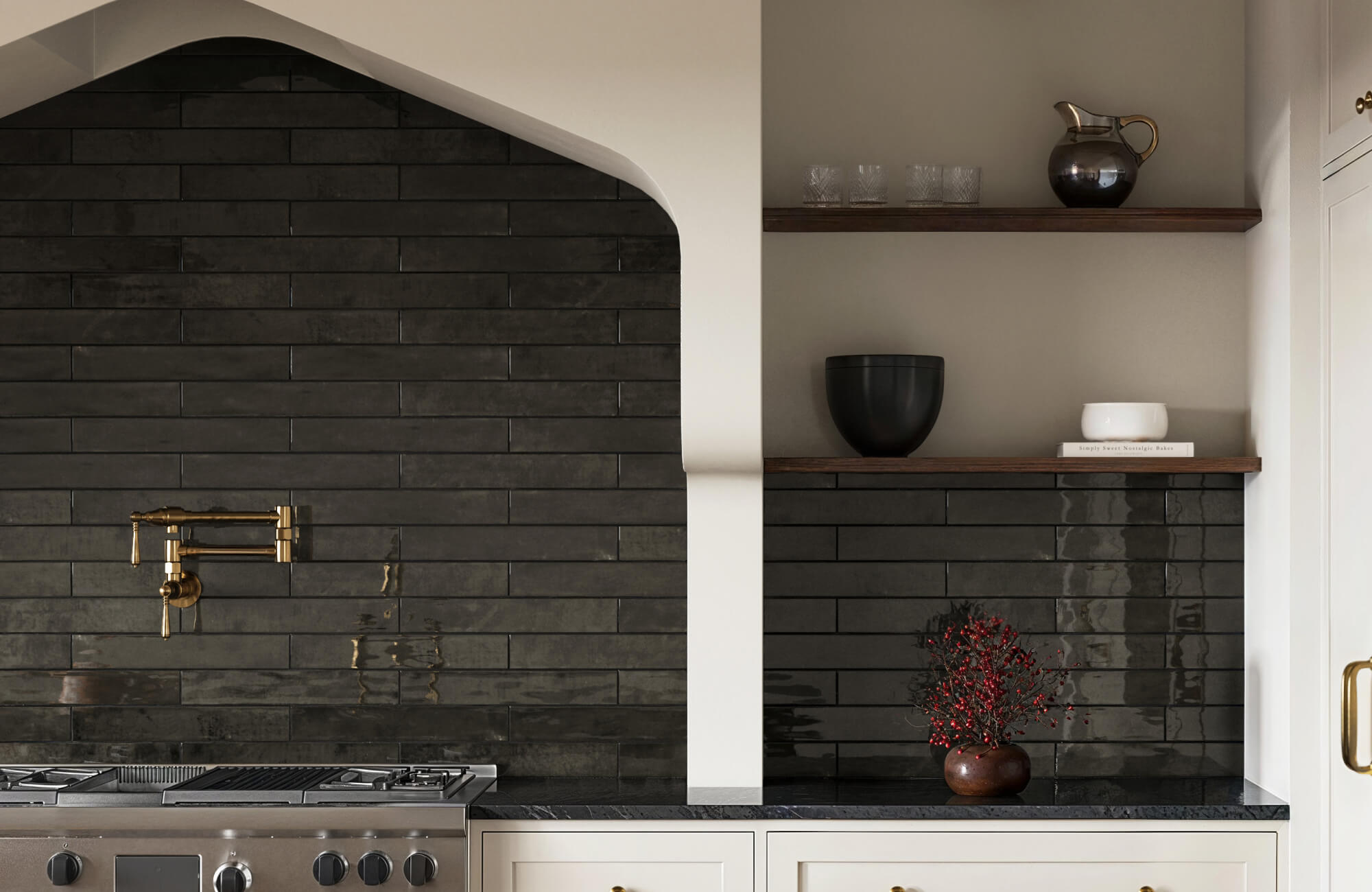With its alternating squares of contrasting colors, the checkered pattern is a classic design motif that has adorned countless surfaces throughout history. While its presence can be found in various rooms and settings, it is particularly prevalent in kitchens. This article delves into the reasons behind this enduring popularity, exploring the historical, practical, and aesthetic factors that have contributed to the checkered kitchen floor's timeless appeal.

Historical Perspective
The checkered pattern, with its stark contrast of light and dark squares, has a history as ancient as civilization itself. While its precise origins remain shrouded in the mists of time, its prevalence in various ancient cultures suggests a deep-rooted significance.
Ancient Roots
Egypt, the cradle of civilization, offers some of the earliest glimpses of the checkered motif. Intricate patterns adorning the walls of tombs and temples hint at its symbolic importance. Some scholars propose that the black and white squares represented the duality of life and death, or perhaps the cosmic order. Similarly, in ancient Rome, checkered floors were discovered in opulent villas, their geometric precision a testament to the Romans' love for order and symmetry. The pattern might have symbolized the structured nature of Roman society or the practical division of space within a dwelling.
Medieval and Renaissance Influence
The Middle Ages witnessed the checkered pattern's transition from symbolic embellishment to a functional and aesthetic element in architecture. The pattern became a staple in the design of castles and monasteries, where it was often incorporated into floor tiles. The stark contrast of the squares created a sense of order and clarity within the often imposing spaces of these buildings. Moreover, the checkered floor could serve as a practical guide, dividing large halls into functional zones. Religious symbolism also intertwined with the checkered pattern during this period. In some Christian contexts, the black and white squares were interpreted as representing the earthly and the divine, or good and evil. This symbolic interpretation added a layer of spiritual significance to the pattern.
The Renaissance marked a renewed appreciation for classical aesthetics, and the checkered pattern experienced a resurgence in popularity. Elaborate marble checkered floors graced the palaces and villas of the wealthy, showcasing the era's penchant for grandeur and geometric precision. The pattern's ability to create a sense of spaciousness and elegance made it a favored choice for grand halls and reception rooms.
Checkered Floors in Domestic Settings
As society evolved, so too did the use of the checkered pattern. Gradually, it made its way from the grand public spaces of castles and palaces to the more intimate realm of domestic interiors. The Dutch, renowned for their tile-making skills, embraced the checkered pattern with enthusiasm. Their Delft blue tiles, adorned with intricate checkered designs, became synonymous with Dutch domesticity. These tiles transformed kitchens and entryways into vibrant and welcoming spaces.
The Victorian era witnessed another surge in the popularity of checkered floors. The pattern was often incorporated into kitchen and hallway designs, where its practicality and visual appeal made it a popular choice. Linoleum, a new and affordable flooring material, allowed for the mass production of checkered floor coverings, making the pattern accessible to a wider audience.

Practical Benefits of Checkered Kitchen Floors
The checkered floor pattern is not only a design classic but also a practical choice for modern interiors. The checkered motif offers several functional advantages that make it a smart option for busy areas like kitchens. Let’s explore how the unique attributes of checkered floors enhance durability, safety, and spatial organization, transforming them into a practical and stylish kitchen flooring solution.
Durability and Maintenance
Beyond its aesthetic appeal, the checkered floor has proven to be a remarkably practical choice for busy areas, particularly kitchens. Composed of durable materials such as ceramic tile, porcelain, stone, or even resilient vinyl, checkered floors are designed to withstand the rigors of daily life. Porcelain checkered tiles, specifically, are a premium choice for modern kitchens due to their exceptional durability and sophisticated appearance. These materials are designed to withstand heavy usage and resist stains, scratches, dents, and impacts, making them both a practical and elegant option for any kitchen floor.
The Palmer 12x12 Matte Porcelain Tile in Grey, featured in the photo, perfectly showcases the blend of durability and timeless design. Its soft grey tones bring a subtle elegance to the kitchen while maintaining a neutral base that complements various cabinetry and countertops. The tile's matte finish enhances its slip resistance, making it ideal for high-activity spaces. Additionally, its robust porcelain composition ensures resistance to wear and tear, making it a long-lasting solution for busy households.
Cleaning and maintenance are also simplified by the checkered pattern. The distinct contrast between the squares effectively camouflages dirt, spills, and minor stains, reducing the frequency of deep cleaning. A quick sweep or mop is often sufficient to restore the floor's pristine appearance. Moreover, the individual squares can be replaced if damaged, without requiring the entire floor to be redone. This modularity contributes to the floor's long-term practicality. However, it is still best to follow the manufacturer's instructions for both the tiles and grout to ensure a long-lasting, high-quality finish and prevent potential issues down the road.
Visual Clarity and Safety
The stark contrast between the light and dark squares in a checkered floor significantly enhances visual clarity, making it a safer choice for areas prone to spills or clutter. The human eye is naturally drawn to the defined edges of the squares, making it easier to spot potential hazards. For instance, a dropped utensil or a spilled liquid is more readily visible on a checkered floor than on a solid-colored one, reducing the risk of accidents. In kitchens, where spills and clutter are common, this visual clarity is paramount. It helps to prevent slips and falls, especially for elderly individuals or young children. The checkered pattern's ability to create a clear visual field contributes to a safer kitchen environment.
Defining Spaces
The checkered floor can be a powerful tool for spatial organization, particularly in open-plan kitchens where distinct zones need to be defined. By using different colors or sizes of squares, or by creating borders with the pattern, it's possible to delineate various areas within the kitchen. For instance, a larger, bolder checkered pattern can designate the cooking area, while a smaller, more subtle pattern can mark the dining space. This spatial definition not only enhances the kitchen's functionality but also contributes to its aesthetic appeal. The checkered floor becomes a visual anchor, guiding the eye and creating a sense of order and harmony within the room. It can also help to differentiate between different flooring materials, such as wood or carpet, further emphasizing the division of spaces.

Aesthetic Appeal and Design Considerations
The aesthetic charm of checkered floors extends beyond their historical significance, playing a crucial role in modern design. It’s crucial then to examine how the checkered pattern influences the atmosphere of a kitchen through color psychology, pattern variations, and styling. By understanding how different color combinations and design elements can impact a kitchen's look and feel, homeowners can make informed choices to create a space that is both visually appealing and uniquely personal.
Color Psychology
The choice of colors on a checkered floor can significantly impact the overall atmosphere of a kitchen. Color psychology suggests that different hues evoke specific emotions and sensations. For instance, a black and white checkered floor exudes a classic and timeless elegance, creating a sense of order and sophistication. A blue and white combination can evoke feelings of calmness and serenity, making it a suitable choice for a kitchen where relaxation is desired. Conversely, a red and white checkered floor can stimulate appetite and create a lively, energetic ambiance. However, it’s essential to use red judiciously as it can also be perceived as aggressive. Green and white can bring a sense of nature indoors, promoting a feeling of freshness and vitality. Yellow and white, on the other hand, can create a cheerful and optimistic atmosphere. By carefully considering the psychological impact of different color combinations, homeowners can select a checkered floor that aligns with their desired kitchen mood.
Pattern Variations
While the classic black and white checkered pattern is undeniably iconic, there are countless variations to explore. Experimenting with different colors, sizes, and orientations of the squares can create unique and visually striking effects. For instance, using larger squares can create a bolder and more dramatic look, while smaller squares can produce a more subtle and refined appearance. Incorporating a gradient of colors within the pattern can also add depth and dimension. Alternating square sizes or creating diagonal patterns, on one hand, can introduce a playful and contemporary element. Beyond traditional squares, checkered floors can also incorporate other geometric shapes, such as hexagons or triangles, to create intriguing visual patterns. These variations offer endless possibilities for customization and self-expression.
Styling and Coordination
Integrating a checkered floor into a kitchen's overall design requires careful consideration of style and coordination. A black and white checkered floor can serve as a neutral foundation for both modern and traditional kitchens. In a modern setting, pair it with sleek stainless steel appliances, minimalist cabinetry, and bold accent colors. To create a rustic ambiance, combine it with warm wood tones, wrought iron accents, and natural textiles. For a more eclectic style, mix and match different patterns and textures.
Remember that a checkered floor can be the focal point of the room as well, so choose complementary colors for walls, countertops, and cabinetry. Neutral colors like white, gray, or beige can also provide a balanced backdrop for a vibrant checkered floor. When selecting countertop materials, consider the overall aesthetic. A white marble countertop can create a classic and elegant look with a black and white checkered floor, while a butcher block countertop can add warmth and character to a rustic kitchen. Incorporate the colors from the checkered floor into other elements of the kitchen decor, such as curtains, rugs, or artwork, to create a cohesive and visually appealing space.
Ultimately, the key to successfully incorporating a checkered floor into a kitchen lies in careful planning and a keen eye for design. To visualize how these design elements come together, use Edward Martin’s augmented reality (AR) tool to experiment with different combinations and see how the checkered floor integrates with your kitchen’s design. For personalized guidance, our design consultation service offers expert advice to help you select the perfect style and coordination, ensuring a cohesive and stunning result.

Emerging Trends in Checkered Floor Designs
As design evolves, so do the ways we incorporate classic elements like checkered floors into modern interiors. Today’s checkered floors are not only about traditional patterns but also reflect innovative trends and contemporary styles. This section explores the latest design advancements, highlighting how checkered floors can be updated to fit modern aesthetics and functionality.
Sustainable Materials and Eco-Friendly Options
The rise of eco-conscious design has introduced new, sustainable materials for checkered floors. Innovations include recycled materials and eco-friendly production processes. Recycled glass tiles and reclaimed wood, for instance, offer sustainable choices without compromising style. These options allow homeowners to enjoy the classic charm of checkered floors while minimizing their environmental impact.
Technology-Enhanced Designs
Advancements in technology have revolutionized floor design, including checkered patterns. Smart flooring systems integrate with home automation, offering features such as temperature control and lighting effects. High-definition printing technology also allows for custom designs and intricate patterns that were previously impossible, making it easier to achieve a personalized look.
Bold and Unexpected Color Palettes
Modern checkered floors are embracing bold and unexpected color combinations. Designers are moving beyond traditional black and white to explore vibrant hues and gradients. This trend allows for a more dynamic and customized look, transforming the checkered pattern into a statement piece that can define a room's character.
Mixed Materials and Textures
Combining checkered patterns with various materials and textures is a growing trend. Incorporating elements like wood, metal, or textiles into checkered designs can create a unique and layered effect. This approach enhances the floor's visual interest and aligns with the trend toward mixing different materials to add depth and dimension to interior spaces.

The Enduring Charm of Checkered Floors
Checkered floors remain a timeless design motif choice due to their rich history and adaptability across various styles. Their blend of practicality and visual appeal enhances both traditional and modern spaces, offering a versatile foundation for creative design. This enduring charm allows checkered floors to seamlessly integrate into any interior while sparking imaginative possibilities.
A Tapestry of Influences
The checkered floor's longevity can be attributed to its ability to seamlessly integrate into diverse design styles. From the classic elegance of traditional kitchens to the contemporary flair of modern interiors, the checkered pattern finds its place. Its adaptability stems from the endless variations in color, size, and pattern, allowing for customization to suit any aesthetic preference. Moreover, the checkered floor's historical significance adds a layer of depth and character. Its presence in ancient civilizations, medieval castles, and Renaissance palaces imbues it with a sense of heritage and timelessness. This rich history resonates with homeowners seeking to infuse their spaces with a touch of classic elegance or a nod to architectural traditions.
A Symphony of Practicality and Style
The checkered floor pattern is a harmonious blend of style and functionality. Its visual appeal extends beyond mere aesthetics, offering practical benefits that enhance a room’s overall design. As previously mentioned, the contrasting squares create a sense of order and clarity, which can visually define different areas within an open-plan kitchen or living space. This spatial delineation not only contributes to the room’s organization but also makes it easier to navigate, especially in busy areas. Additionally, the pattern’s visual interest can complement various decor styles, from traditional to contemporary, making it a versatile choice that adds both character and practical benefits to any space.
A Catalyst for Creativity
The checkered floor serves as a canvas for creative expression. Designers and homeowners alike find inspiration in the endless possibilities offered by this versatile pattern. Whether it's experimenting with different color combinations, playing with square sizes, or incorporating geometric variations, the checkered floor allows for a unique and personalized touch. Moreover, the checkered floor can serve as a focal point or a complementary element in a room's design. It can be paired with a variety of materials, textures, and colors to create harmonious and visually interesting spaces. This adaptability ensures that the checkered floor remains a relevant and inspiring design choice.







